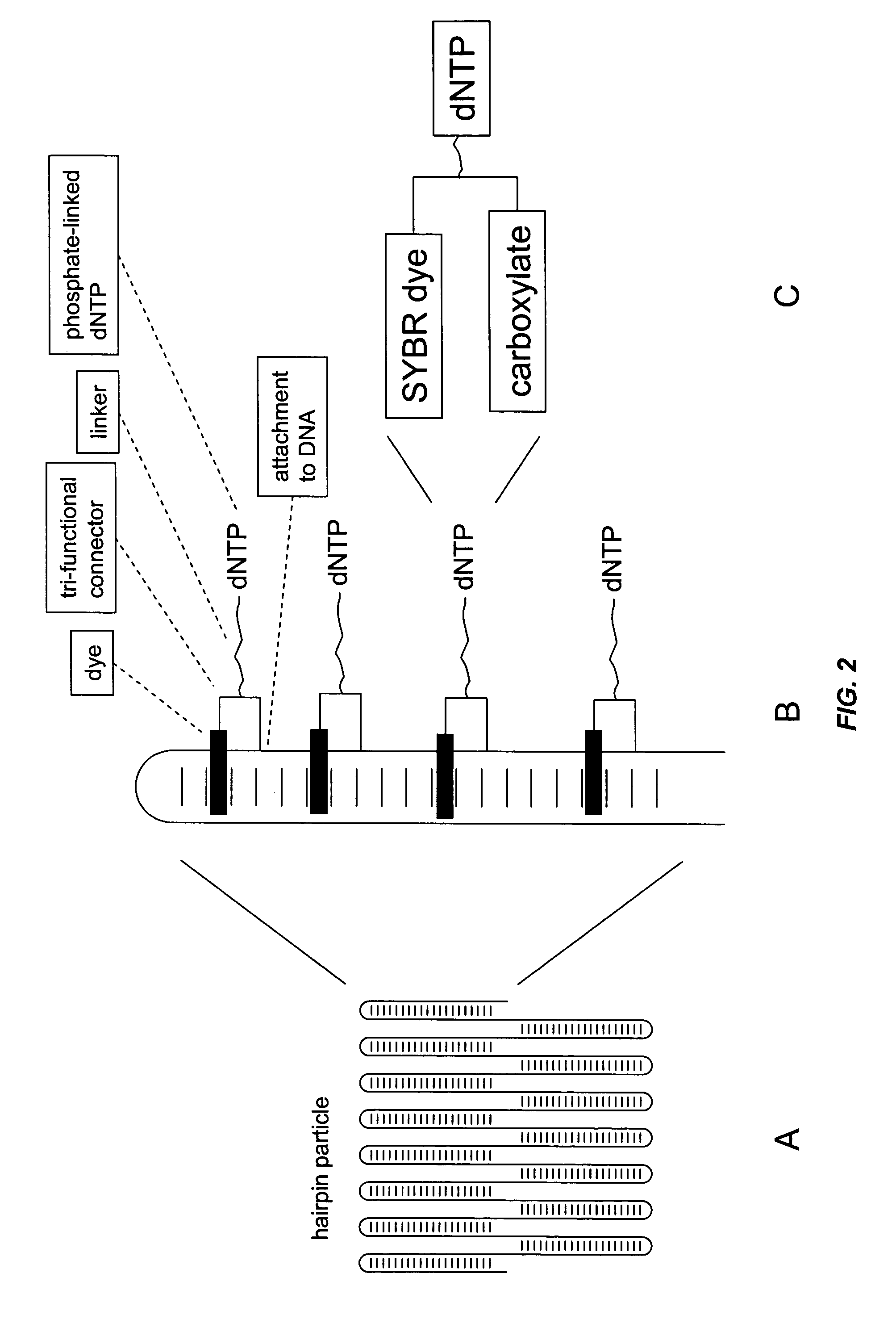Field-switch sequencing
a field-switch, sequencing technology, applied in the field of field-switch sequencing, can solve the problems of reducing the cost of delivering finished base sequence, several non-sizing dna sequencing methods have been demonstrated or proposed, and all are limited by short read lengths, so as to reduce the cost of sequencing, the effect of high multiplexing and sufficient resolution
- Summary
- Abstract
- Description
- Claims
- Application Information
AI Technical Summary
Benefits of technology
Problems solved by technology
Method used
Image
Examples
example 1
Field-Switch Chamber Construction
[0108]This example illustrates the construction of a 10 μm×250 μm two-electrode sequencing chamber of the present invention comprising a spin-coated SU-8 spacer permanently bonded to an ITO-coated coverslip. The ITO surface in the bottom of the chamber is then coated with a permeation layer by controlled electropolymerization with biotin-pyrrole. The chamber is closed with a top electrode.
[0109]Chamber Construction. Microscope coverslips (25×25×0.17 mm) are coated with ITO to a resistivity of 140 ohm / square and refractive index 1.52 (ZC&R Inc.). The coverslips are cleaned by successive washes in Decon 77, deionized water and chloroform. After oven-drying for 30 min and cooling to room temperature, the coverslips are coated with 10 um of SU-8 photoresist by spin casting. The resist is exposed with collimated UV light through a contact mask to give a 250 um diameter hole and a 2×2 mm contact pad. The photoresist is then baked and developed (Shipley Mic...
example 2
Construction of a DNA Nanoparticle by Rolling Circle Replication
[0112]Template construction. The circular template used for the rolling circle amplification was constructed by ligating two 5′ phosphate-labeled oligos (oligo 1 and oligo 2) that contain regions of inverted repeated DNA, forming a hairpin structure (FIG. 8a-b). Ten pmoles of each oligo were combined with 1× final concentration of T4 ligation buffer (New England Biolabs) in a volume of 20 uL. The mixture was incubated at 90° C. for 1 min and then cooled to 20° C. T4 DNA ligase (100 units, New England Biolabs) was then added to the reaction mixture and incubated at 24° C. for 3 hours. The ligated template was purified on a 6% TBE-Urea denaturing acrylamide gel, cutting the ligated circular template from the gel, and extracting the DNA from the gel fragment by incubating in 10 mM Tris pH 8 for 8 hours at 20° C. (FIG. 9a).
[0113]In one embodiment, a DNA particle is constructed by rolling circle amplification of a DNA templa...
example 3
Synthesis of dCTP-PEG8-Cys-SYBR-101
[0116]Deprotection of BOC-amino PEG amine (FIG. 10, cpd 1). BOC-amino PEG amine (PolyPure, 1 gram), was added to a trifluoroacetic acid / chloroform solution (1:1 v / v, 20 mL). Reaction was stirred at room temperature for 2 hours. NaHCO3 (10 mL, 10 mM) was slowly added to the reaction. The aqueous layer was separated from the organic layer and retained. Chloroform was added and two extractions (20 mL each) were performed. To the aqueous layer, ethyl ether (20 mL) was added and the extraction was performed twice. The aqueous layer was dried in vacu. The final product was a clear oily residue, and weighed approximately 1 gram. Yield was estimated at less than 100% due to possible salts and water still present in sample. 1H NMR, D2O: delta 3.675 (t, 4H), 3.61 (m, 24H), 3.1 (t, 4H). ESI MS [M+1] calculated 369.3, observed [M+1] 369.2
[0117]dATP-PEG8-amine (FIG. 11, cpd 2). 13.3 mg dATP from Sigma (24.8 μmol, 1 equiv) and 190.6 mg EDC from Aldrich (992 μmol...
PUM
| Property | Measurement | Unit |
|---|---|---|
| thick | aaaaa | aaaaa |
| diameter | aaaaa | aaaaa |
| wavelengths | aaaaa | aaaaa |
Abstract
Description
Claims
Application Information
 Login to View More
Login to View More - R&D
- Intellectual Property
- Life Sciences
- Materials
- Tech Scout
- Unparalleled Data Quality
- Higher Quality Content
- 60% Fewer Hallucinations
Browse by: Latest US Patents, China's latest patents, Technical Efficacy Thesaurus, Application Domain, Technology Topic, Popular Technical Reports.
© 2025 PatSnap. All rights reserved.Legal|Privacy policy|Modern Slavery Act Transparency Statement|Sitemap|About US| Contact US: help@patsnap.com



